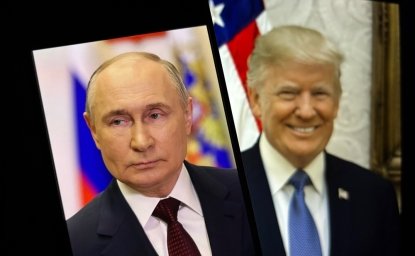258. Ten Years After: Bosnia-Herzegovina on the Tenth Anniversary of the Outbreak of War

The legacy of the war in Bosnia, ten years after, is deeply ambivalent. There is peace in Bosnia, and as far as one can see, no one is preparing for a new war. This is an immense achievement. The new Bosnia, however, has yet to come to terms with itself. There is a danger that the country will become a destitute backwater now that the era of massive foreign aid and reconstruction is coming to a close. What this means for the people of Bosnia, who remain at odds over the nature of their new country, remains unclear. Many, of course, will seek to leave, robbing the country of its most valuable resource its young, its educated, and its talented citizens.
The international community, acting through the Office of the High Representative, has recently attempted to address the problem of Bosnia's crisis of identity by imposing new constitutional amendments on the country's two entities: the Muslim-Croat Federation and Republika Srpska. Under these constitutional provisions, all three ethnic communities are "constitutive" throughout the entire republic. As a practical matter, this undercuts the claims of the Serbs of being the titular nationality of Republika Srpska, as well as the ability of Muslims or Croats to make such a claim within the Federation. In practice, this decision is intended to lead to representation of the "other" ethnic communities in the political structures of the two entities, as well as strengthening the central government. The point to be made is that these modifications of the Dayton Accords are based on a particular view of the Bosnia of the past and a search to recover that past, albeit in a civil society context. To do this, however, requires a deeper understanding of the conflict that tore the republic apart.
Has the scholarship on the war period changed its focus, tone, or our view of Bosnia? What follows is a brief summary. It makes an assumption that some may challenge but which seems borne out as we distance ourselves from the conflict. This assumption is that, for understandable reasons, there was a rush to describe Bosnia in simple (even simplistic) terms while the war was raging. Scholarship is now more nuanced. However, as I shall suggest, we still lack the historical distance that would allow us to view the period of the conflict in terms of historical contingencies and free of the policy driven agenda of so much scholarship on Bosnia. This may in turn have consequences for the present effort to define Bosnia's future, if indeed that future is seen in terms of a simplified version of the past and the conflict that followed.
These observations are particularly relevant in respect to the first wave of scholarship on the war, one characterized by instant analyses of the conflict and hurried efforts to produce histories of Bosnia in conformity with prevailing views of the struggle. A second wave of scholarly works has followed, more analytical and often comparative, in which the war in Bosnia is analyzed as a case study in conflict resolution, or in the context of the international response to human rights violations (to give only two examples).1
There are now the first signs of a new literature based on case studies carried out within Bosnia, as well as some efforts at synthesis. This literature is the work of young British and American graduate students and a number of European scholars, among whom anthropologists play a prominent role. This literature is notable for being open-ended in its research findings, rather than being guided by predetermined policy preferences or priorities.2
Will this new scholarship change our view of the conflict? Much of this work is at an early stage. For example, the massive Dutch study of the Srebrenica massacre has just been released, but will undoubtedly take time to digest. Media dispatches report that the study finds no evidence that Milosevic was involved in the Srebrenica massacre. Will this change (or should it change) our view of Slobodan Milosevic's role in the war? My sense is that this conclusion will be ignored by those who believe Milosevic was "worse than Hitler," while his apologists will try to use this information to exonerate him of responsibility for atrocities committed by the Serbs in Bosnia.
This again brings up the problem of historiography as distinct from agenda-driven scholarship, and what the former approach may offer by way of insights into the war. I propose to use as an example the controversy over whether the war in Bosnia could have been prevented had the West intervened at the outset. If we look at the war as an historian might some years hence, we might find in the actions and decisions of the actors themselves uncertainties, dilemmas, and the necessity of choosing among different strategies. If such options existed, it is possible to speculate that the conflict itself could, in turn, have had different outcomes.
I would suggest that the war between Serbia and Croatia set in motion the events that sealed the fate of Bosnia, resulting in the state's violent partition and in massive ethnic cleansing. If this is so, historians of the Bosnian war might wish to take a closer look at the events that led to the outbreak of fighting in Croatia, and the role of the Krajina Serbs in provoking the confrontation. Although Milosevic had stated publicly prior to the outbreak of the Croatian conflict that Serbia would go to war to defend the Serbs of Krajina, he was quick to distance himself from the Krajina Serbs after the UN administered cease-fire was agreed to in January 1992. Furthermore, there were weighty reasons for Milosevic to strike a deal with Franjo Tudjman (Croatia's president and strongman) rather than go to war with Croatia. Most important among these was that both parties wished to carry out the partitioning of Bosnia. This became apparent in the course of 1991, when Milosevic and Tudjman met several times to discuss the fate of Bosnia, and subsequently, in the cooperation between the two (and with the international community) in drafting proposals to resolve the Bosnian conflict.
The discussions of the partitioning of Bosnia between Milosevic and Tudjman are only partially known. It appears, meanwhile, that a partition of Bosnia to the advantage of Serbia and Croatia, if it took place, would be along the lines of the 1939 Sporazum Agreement (this, at least, is what Tudjman insisted on). That agreement, while it erased the traditional borders of Bosnia, did not partition or divide the Bosnian Muslims (as an ethnic group), as was to happen during the recent war. Rather, the Muslims of Bosnia (along with those of Sandzak)remained within Yugoslavia. Such a solution, if agreed to by all parties in 1991, could have avoided the ethnic cleansing of the Muslim population.3 Additionally, if it did not entail the destruction of Bosnia as a republic within the existing federation (and of this we cannot be sure), Bosnian Muslims could have retained a political role within a reduced, or rump, Yugoslavia.
Muslim leader Alija Izetbegovic and the SDA were opposed to such a solution to the Bosnian question, and would have resisted the motion if it had been proposed to them by Milosevic and Tudjman. But it must be remembered that in the crucial referendum for independence in the spring of 1992, the Bosnian Croats, many of whom wished to see Bosnia partitioned, voted for the independence of Bosnia instead. Some acted out of conviction, but many voted for independence under pressure from Zagreb, which feared a vote for partition could be used as a precedent for the secession of the Krajina Serbs from Croatia. A potential Serb-Croat coalition with a majority of the vote would have placed the Muslim push for the independence of Bosnia in jeopardy.4 Under such conditions, there would have been strong pressure by the pro-Yugoslav camp of the Muslims (a tiny but influential minority of the older clergy plus powerful businessmen, including Fikret Abdic who had won the most votes in the race for president in 1990) for Bosnia to remain in Yugoslavia, least the republic be partitioned, not along the lines of the Sporazum of 1939 but as a result of war and ethnic cleansing.
The policy implications of this scenario are rather obvious for those who would have wished to see the West step in and halt the Bosnian war in its tracks.(5) Yet, and this is the central point, the persuasiveness of this argument for early intervention rests not on an activist's desire to deploy American military power, but in the soundness of the historical argument that the war in Croatia could have been brought to a swift conclusion, following which Bosnia could have been persuaded to join a rump Yugoslavia. The scenario also raises the question of whether the West was, absent any direct provocation, ready to apply stratagems more appropriate to the previous century to end a war in a region in which, up to that time, it had little direct interest.
Let me now turn to another question which has occasioned much debate, and which is tied into the findings of the new scholarship on Bosnia. It is the contention that the war in Bosnia is a reflection of "ancient hatreds," and the even more frequently voiced attack on this assertion. Two points come to mind: first, it is very hard for any long-term observer of Yugoslavia to be deluded into thinking that national stereotypes and fears are lightly acquired, and can be easily changed. Second, it is also true that a unique feature of the conflict in Bosnia was that it had been preceded by a long period of peace; that people did intermix; that, in brief, Bosnia was not Northern Ireland, or, for that matter, Kosovo.
New studies, as well as old ones, shed some light on this paradox and help explain why such conflicting opinions on the nature of ethnic relations in Bosnia persist. Above all, current research reminds us that there were many Bosnias. Differences in relations among ethnic communities in different regions of Bosnia were pronounced and of long standing (this was also true of the attitudes of the urban and rural population). These differences had roots in the past and were made possible by one of Bosnia's more unique features - the absence of large population displacements and replacements along ethnic lines (with the exception of certain border regions). This meant that traditional attitudes, both negative and positive, were allowed to endure and to become deeply embedded in local communities, to emerge just prior to the war, and then, during the conflict itself. In some cases, these relationships allowed "ancient hatreds" to surface quite rapidly, in others, not at all.(6) In both cases, the history of the locality, broadly understood, was the determining factor. To state the case in a slightly different fashion, ethnic relations are shaped over time and in response to local experience. Whether this temporal dimension is ancient or relatively recent is largely beside the point.
These brief excursions into Bosnia's recent past suggest why, ten years afterward,Bosnia's future remains so uncertain. It is both the nature of the Bosnian community and the basis upon which it can endure as a multi-cultural and multi-national state that remain controversial. Bosnia is still searching for its identity outside of Yugoslavia, so far without success. And while the international community hopes that its recent efforts to strengthen Bosnian institutions by revising the Dayton Accords will allow Bosnia to stand on its own feet, the opposite seems more probable. The tutelary role of the international community thus continues to grow, even as the resources to carry out this task diminish. The positive element in this picture is the apparent determination, at least in the postwar generation of Muslims, Croats and Serbs, not to go to war as long as the international community guarantees their security. The legacy of the Bosnian conflict has therefore been a restraining one, even if Bosnia's future remains clouded. One can only hope that future generations will share this desire to avoid another catastrophe.
1 For works of this period, see the bibliography in Steven L. Burg and Paul S. Shoup, The War in Bosnia: Ethnic Conflict and International Intervention (1999), and Quintin Hoare and Noel Malcolm, A Critical Bibliography of Works Relating to Bosnia-Herzegovina Published Since 1990 in West European Languages 1999).
2 This third wave actually began over five years ago with the work of Tone Bringa, Being Muslim in the Bosnian Way (1995). More recent examples include Ivana Macek, War Within: Everyday Life in Sarajevo Under Siege (2000), Ger Duijzing's study of Srebrenica, shortly to be published as part of the Dutch report (infra.), and the edited volume of Xavier Bougarel and Nathalie Clayer, Le Nouvel Islam balkanique: Les musulmans, acteurs du post-communisme 1990-2000 (2001).
3 The proposal for a partition of Bosnia along the lines of the 1939 Sporazum Agreement has usually been attacked as a plan to create a greater Croatia and a greater Serbia. For this position, as well as the assertion that it was the 1939 division that Tudjman had in mind (with the addition of Cazinska Krajina to Yugoslav Bosnia), see Stjepan Mesic, "The Road to War," in Branka Magas and Ivo Zanic (eds.), The War in Croatia and Bosnia-Herzegovina, 1991-1995 (2001).
4 In the 1991 census, the Muslims were 43.7 percent of the population, the Serbs 31.4 percent and the Croats 17.5 percent. The Serbs and Croats combined were 48.9 percent. The remaining 7.4 percent were Yugoslavs and others.
5 That is, that the West should have threatened to go to the aid of Croatia in 1991, and thus, brought the war in Croatia to a rapid end.
6 Svetlana Broz, in her volume, Dobri ljudi u vremenu zla (2000): 10-14, tells the story of Donje Baljvine, a village in the vicinity of Mrkonjic Grad, where Serbs and Muslims simply refused to engage in the communal violence swirling around them, and were, indeed, left to their own devices by the Serb forces who controlled the region for most of the war.
Paul Shoup spoke with Robert Hayden and Stevan Lilic at an EES seminar on April 5, 2002. The above is a summary of Dr. Shoup's remarks. Meeting Report #258.
Author

Global Europe Program
The Global Europe Program is focused on Europe’s capabilities, and how it engages on critical global issues. We investigate European approaches to critical global issues. We examine Europe’s relations with Russia and Eurasia, China and the Indo-Pacific, the Middle East and Africa. Our initiatives include “Ukraine in Europe”—an examination of what it will take to make Ukraine’s European future a reality. But we also examine the role of NATO, the European Union and the OSCE, Europe’s energy security, transatlantic trade disputes, and challenges to democracy. The Global Europe Program’s staff, scholars-in-residence, and Global Fellows participate in seminars, policy study groups, and international conferences to provide analytical recommendations to policy makers and the media. Read more

Explore More
Browse Insights & Analysis
360° View of How Southeast Asia Can Attract More FDI in Chips and AI

The Growing Transatlantic “Big Tech” Rift Explained

Mapping Undersea Infrastructure Attacks in the Baltic Sea
